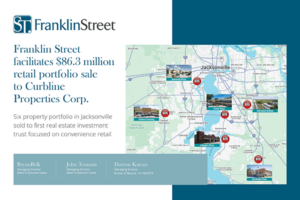The Business Journal recently spoke with veteran real estate professionals Peter Anderson, vice president of Pattillo Industrial Real Estate and Northeast Florida NAIOP president; Hobart Joost Jr., principal and industrial team director at Colliers International Northeast Florida; and Monte Merritt, senior director with Franklin Street’s Jacksonville office, to discuss their opinions and predictions on the Jacksonville port dredging project and its effects on the commercial real estate market. Here are their edited responses:
How important is the dredging for Jacksonville’s economy and CRE markets?
Anderson: Jaxport is an important component of Jacksonville’s diverse economy. Some goods flowing through Jaxport are stored in Northeast Florida, which leads to meaningful capital investment in commercial real estate and jobs. Dredging is not required for auto imports or break-bulk imports. Dredging is not required to maintain Jaxport’s existing primary container traffic with Puerto Rico and the Caribbean. However, dredging is required to handle post-Panamax ships, thus dredging may lead to increased flow of goods through Jaxport and thus lead to additional jobs and capital investment, including commercial real estate.
Joost: The Jacksonville Port Authority is a leading driver for industrial real estate development throughout the region. Jaxport is also, in an indirect way, a driver for the area commercial real estate markets. One case in point is Crowley Maritime Corp.’s ownership of a 113,000-square-foot office building at Regency. If Jaxport was not active, neither would be Crowley. And as a result of Crowley being in Jacksonville, they recently received federal government approvals to ship LNG [liquefied natural gas] to the Caribbean market, another big win for Jaxport.
How long before the dredging will affect the commercial real estate market?
Anderson: Most experts believe that, given a best-case scenario, the dredge completion is seven years out. This is based upon the need to obtain the commitments to fund the project, obtain permit approval, and complete the actual dredging. Consider how long we have worked on the Mile Point issue, which is still incomplete. Thus, there is not a near-term impact on the commercial real estate market in regard to dredging.
Joost: In my opinion, deepening the [shipping] channel to 47 feet will have more of an immediate impact on the industrial market, and over time, more of a residual effect on the balance of the commercial real estate market. As employment and jobs increase, so does the demand for retail services, office space and housing. Supporting this are facts and figures from the Jaxport website:
• The number of positions [jobs] related to cargo activity at the Port of Jacksonville has grown to 108,260, up from 42,647 in 2008.
• A new overall job figure of 132,599 has more than doubled since 2008.
• Direct jobs generated by container activity at Jaxport have grown by 57 percent.
Merritt: The deepening must occur before expansion is evident in the office and industrial markets. I would estimate about a year after completion is when we should start seeing more demand for warehouse space and other industrial/office properties. Originally, local officials were saying the project would be done in 2016, but the completion estimate has now been pushed back to 2017 or 2018.
What are the negative impacts that come with deepening of the port?
Joost: The first is the cost. Over the past history at Jaxport, the Army Corp of Engineers has not been able to give accurate cost figures associated with prior deepening operations. Then there are the environmental concerns with saltwater intrusion and the effect on the plants and animals. This may be lessened by some extent by breaching the Rodman Dam. There needs to be more science. And lastly, blasting the lime rock in certain areas, and the concerns that come with that process.
What are your predictions for the future of Jacksonville’s industrial and office markets?
Merritt: Local real estate executives remain optimistic about the expansion and development of these markets, and I believe the port dredging project is a significant contributor. Although the funding sources are still unclear, it is important for the city to look forward. For industrial, a deeper port will attract additional shipping lines, thus creating a need for more warehouses and distribution centers. For the office market, it will entice businesses that rely on large cargo shipments to relocate or expand to Jacksonville to have a presence near the port.
Major brands that currently operate through the Port of Jacksonville:
Bacardi: Product is distilled in Puerto Rico and shipped through Jaxport in containers and bottled here in Jacksonville, for distribution throughout the United States.
Wal-Mart Stores Inc.: Product is shipped in containers to supply retail stores in Puerto Rico.
Bridgestone Firestone North American Tire LLC: The largest distribution center in the area, at 1 million square feet, uses Jaxport for Asian imports.
The Walt Disney Co.: A recent win for Jaxport. All Disney products bound for Disney World now come through Jaxport.
Volkswagen
Chrysler
Mercedes-Benz
Coach
Rooms To Go
Samsung
Costco
Havertys
Coca-Cola Co.
Bedrosians Tile
Hanes
Heinz



